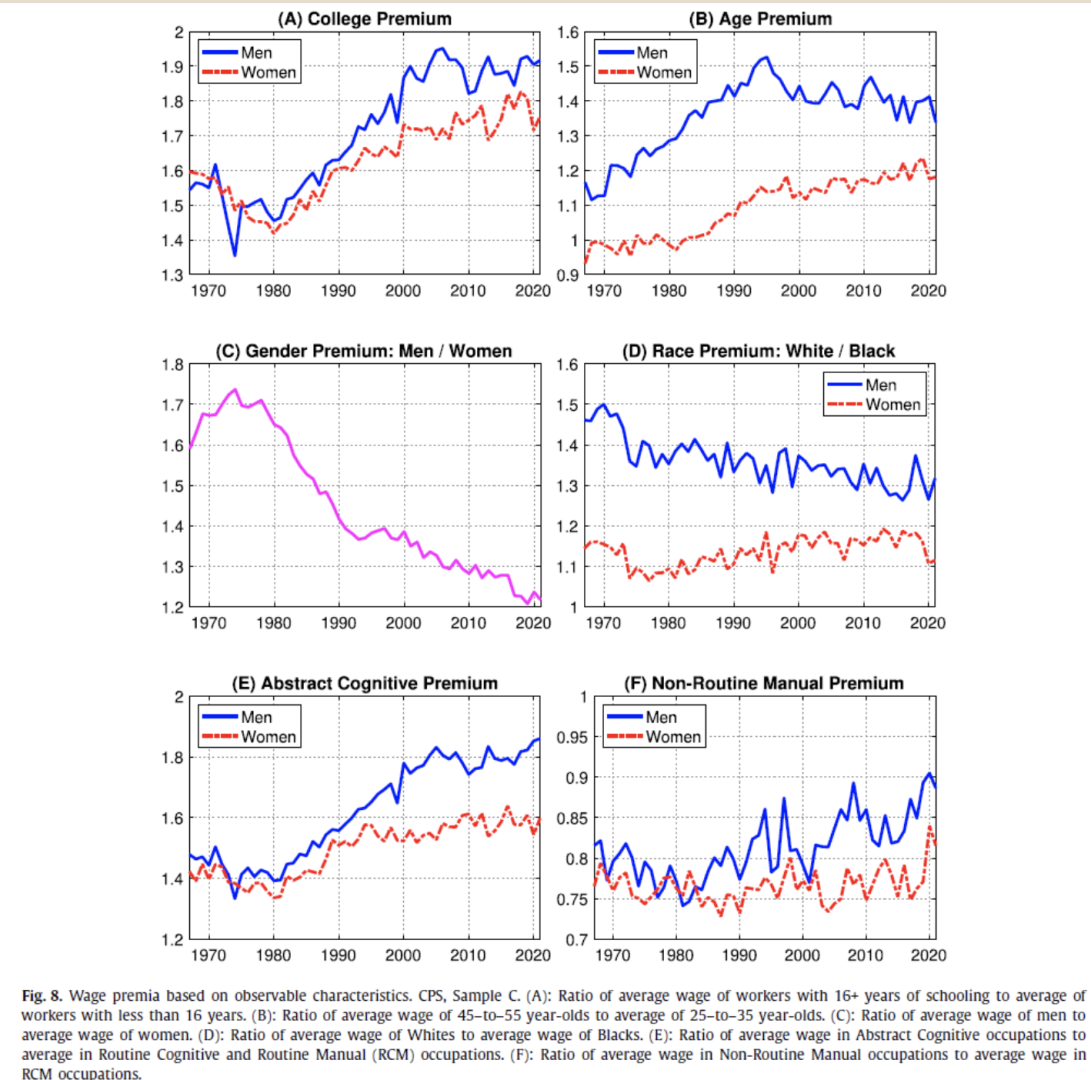Comments
- No comments found

Back in 2010, Jonathan Heathcote, Giovanni L. Violante, and Fabrizio Perri, published a study that compiled data from a number of publicly available sources to measure the evolution of US inequality in income, wages, and wealth over time, with data up through 2006 (“Unequal we stand: An empirical analysis of economic inequality in the United States, 1967–2006,” Review of Economic Dynamics 13(1), 15–51).
Now with the addition of Lichen Zhang as another co-author, the band is back in town with a follow-up, updating their earlier study with data through 2021 (“More Unequal We Stand? Inequality Dynamics in the United States, 1967–2021,”Review of Economic Dynamics, October 2023, 50: 235-266; an ungated working paper version is available from the Federal Reserve Bank of Minneapolis).
The study takes a look at inequality measured in a number of ways: income, consumption, wages; individual-level and household-level; by education level, race/ethnicity, and gender; with adjustments for government payments; and so on. From the abstract:
We find that since the early 2000s, the college wage premium has stopped growing, and the race wage gap has stalled. However, the gender wage gap has kept shrinking. Both individual- and household-level income inequality have continued to rise at the top, while the cyclical component of inequality dominates dynamics below the median. Inequality in consumption expenditures has remained remarkably stable over time. Income pooling within the family and redistribution
by the government have enormous impacts on the dynamics of household-level inequality, with the role of the family diminishing and that of the government growing over time. In particular, largely due to generous government transfers, the COVID recession has been the first downturn in fifty years in which inequality in disposable income and consumption actually declined.
Here, I’ll focus on a subset of these comparisons from a single figure, with some discussion below. This paper is heavy on fact patterns, without trying to describe underlying causes. But even standing alone, the fact patterns provide insight about the evolution of US labor markets.

The upper-left panel looks at the ratio of wages for workers who have (at least) completed a four-year college degree to those who have not. The growth in the wage premium for college workers has been one of the primary drivers of rising inequality of incomes in recent decades: indeed, a widely-held theory is that demand for high-skilled labor has been rising faster than supply. But the college wage premium hasn’t risen much for men since about 2000, and for women since about 2010. However, the education premium for men has risen above the level for women. You can pick your own hypothesis here. Maybe the demand for skilled labor isn’t rising as fast? Maybe colleges in recent years aren’t providing the kind of skilled labor that employers want? Maybe less-skilled labor has become more accustomed to using technology, in such a way that information and computer technology is complementing less-skilled labor more than it used to? It’s a trend that bears watching.
The upper right-hand panel shows the ratio of average wages for 45-55 year-olds compared to the average of 25-35 year-olds. This age premium rose substantially from the 1970s into the early 1990s, but since then has flattened out. Again, pick your hypothesis. The rise of information technology and the internet made some middle-aged skills obsolete, while elevating the wages of some younger workers who could use those skills?
The middle left-hand panel is the gender premium: the ratio of average wage of men to average wage of women. Back around 1970, the ratio of 1.7 worked out to about 59 cents in wages earned by the average woman to $1 earned by the average man. The ratio has now fallen to about 1.2, which is about 83 cents in wages for the average woman compared to $1 earned by the average man. There is an ongoing debate over how much of this difference is accounted for by women being more likely to take on parental responsibilities. Here, I’ll just note that the ratio seems to have fallen notably even in the last decade, and looks as if it is still falling.
The middle right-hand panel is the white/black wage ratio. The white/black ratio for men is consistently higher than for women. However, neither ratio has moved much since the mid-1990s–that is, it hasn’t moved much for a generation.
The last two panels look at ratios across certain kinds of jobs. The bottom left panel looks at the ratio of average wages in “Cognitive” occupations to “Routine Cognitive and Routine Manual” occupations. Basically, “Cognitive” refers to jobs classified as “Professional, Managerial, and Technical,” while the “Routine” occupations comparison category includes “Clerical and Sales,” Production,” and “Operators.” It’s perhaps not surprising that the “Cognitive” jobs pay more. However, the ratio for Cognitive/Routine jobs has been rising pretty steadily for men since the 1970s. For women, the ratio rises up to the mid-1990s, but then more-or-less levels off. It’s not obvious from this comparison why the ratio should differ between men and women, but one possibility is that there are subcategories within “Cognitive” and “Routine” jobs that are not captured by the overall comparison. It’s also interesting that the college wage premium for men hasn’t been rising (as shown earlier), but the ratio between Cognitive and Routine jobs for men has continued to rise–suggesting that “Cognitive” and “College” are not lining up in any precise way.
The bottom right panel looks at the ratio of wages in “Non-Routine Manual” to the same “Routine Cognitive and Routine Manual” occupations from the previous graph. Non-Routine Manual is all jobs categorized as Services; again, the “Routine” jobs include “Clerical and Sales,” Production,” and “Operators.” In general, the “Services” jobs are paid less (as you can see, the ratio on the vertical axis is below 1). But since the 1980s, the wage for “Services” jobs has been creeping a little closer to the ratio for the “Routine” jobs, especially for men. A possible explanation here is that the “Routine” jobs are more likely to be replaced by automation, in a way that means less-skilled workers are becoming able to do these jobs.
I have no bottom line here, except that a dynamic economy evolves, often for the better of many groups, but sometimes for the worse of certain groups as well.
Timothy Taylor is an American economist. He is managing editor of the Journal of Economic Perspectives, a quarterly academic journal produced at Macalester College and published by the American Economic Association. Taylor received his Bachelor of Arts degree from Haverford College and a master's degree in economics from Stanford University. At Stanford, he was winner of the award for excellent teaching in a large class (more than 30 students) given by the Associated Students of Stanford University. At Minnesota, he was named a Distinguished Lecturer by the Department of Economics and voted Teacher of the Year by the master's degree students at the Hubert H. Humphrey Institute of Public Affairs. Taylor has been a guest speaker for groups of teachers of high school economics, visiting diplomats from eastern Europe, talk-radio shows, and community groups. From 1989 to 1997, Professor Taylor wrote an economics opinion column for the San Jose Mercury-News. He has published multiple lectures on economics through The Teaching Company. With Rudolph Penner and Isabel Sawhill, he is co-author of Updating America's Social Contract (2000), whose first chapter provided an early radical centrist perspective, "An Agenda for the Radical Middle". Taylor is also the author of The Instant Economist: Everything You Need to Know About How the Economy Works, published by the Penguin Group in 2012. The fourth edition of Taylor's Principles of Economics textbook was published by Textbook Media in 2017.
Leave your comments
Post comment as a guest